Abstract
Xylan degradation and production of β-xylanase and β-xylosidase activities were studied in cultures of Cellulomonas uda grown on purified xylan from birchwood. β-Xylanase activity was found to be associated with the cells, although in various degrees. The formation of β-xylanase activity was induced by xylotriose and repressed by xylose. β-Xylosidase activity was cell bound. Both constitutive and inducible β-xylosidase activities were suggested. β-Xylanase and β-xylosidase activities were inhibited competitively by xylose. β-Xylanase activity had a pronounced optimum pH of 5.8, whereas the optimum pH of β-xylosidase activity ranged from 5.4 to 6.1. The major products of xylan degradation by a crude preparation of β-xylanase activity, in decreasing order of amount, were xylobiose, xylotriose, xylose, and small amounts of xylotetraose. This pattern suggests that β-xylanase activity secreted by C. uda is of the endosplitting type. Supernatants of cultures grown on cellulose showed not only β-glucanase but also β-xylanase activity. The latter could be attributed to an endo-1,4-β-glucanase activity which had a low β-xylanase activity.
Full text
PDF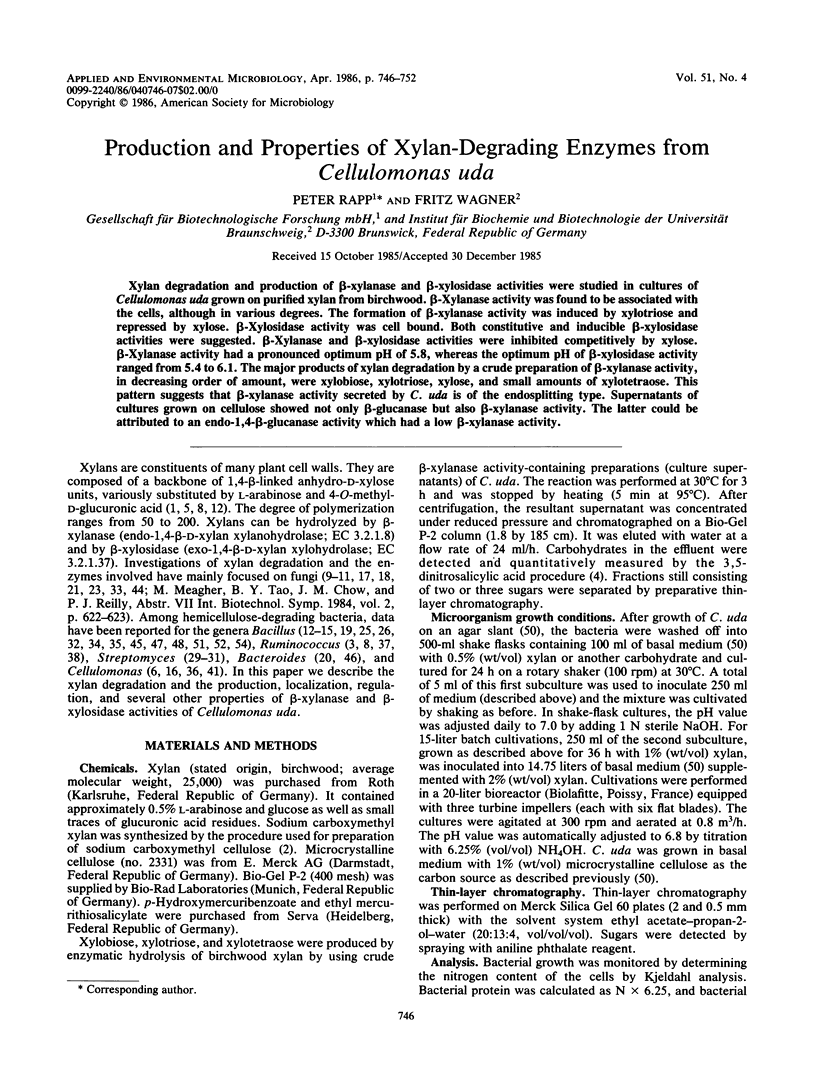
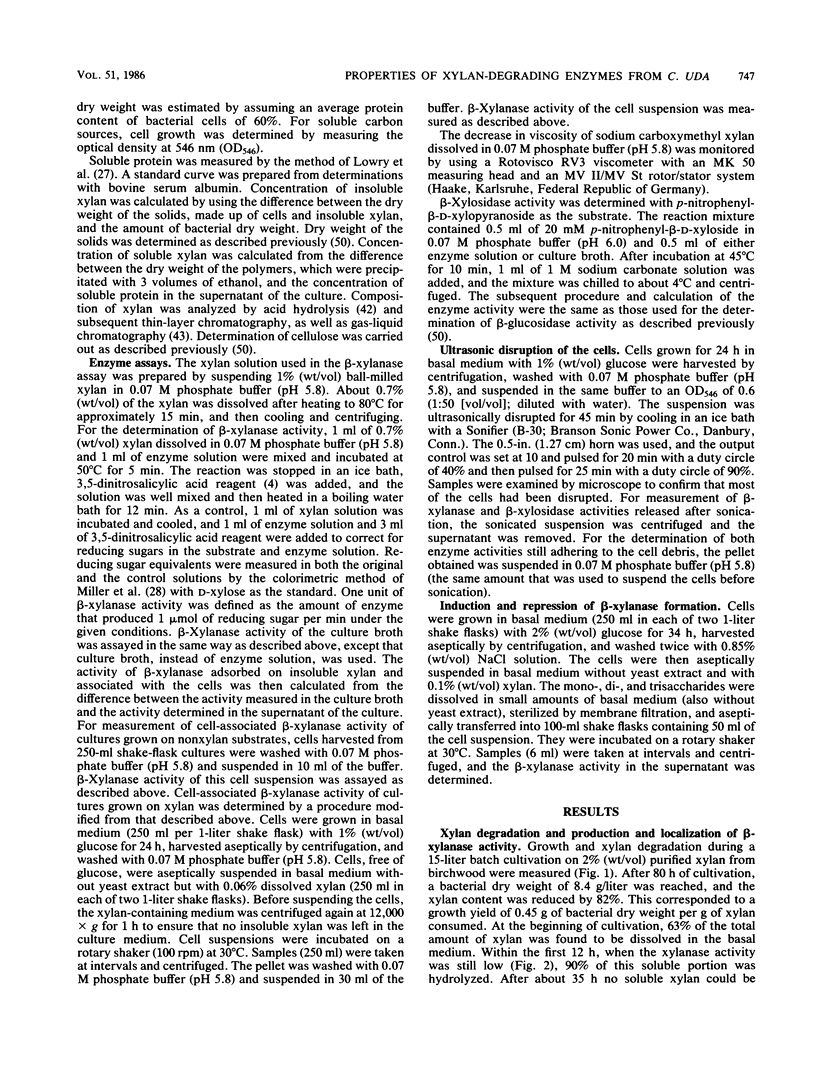
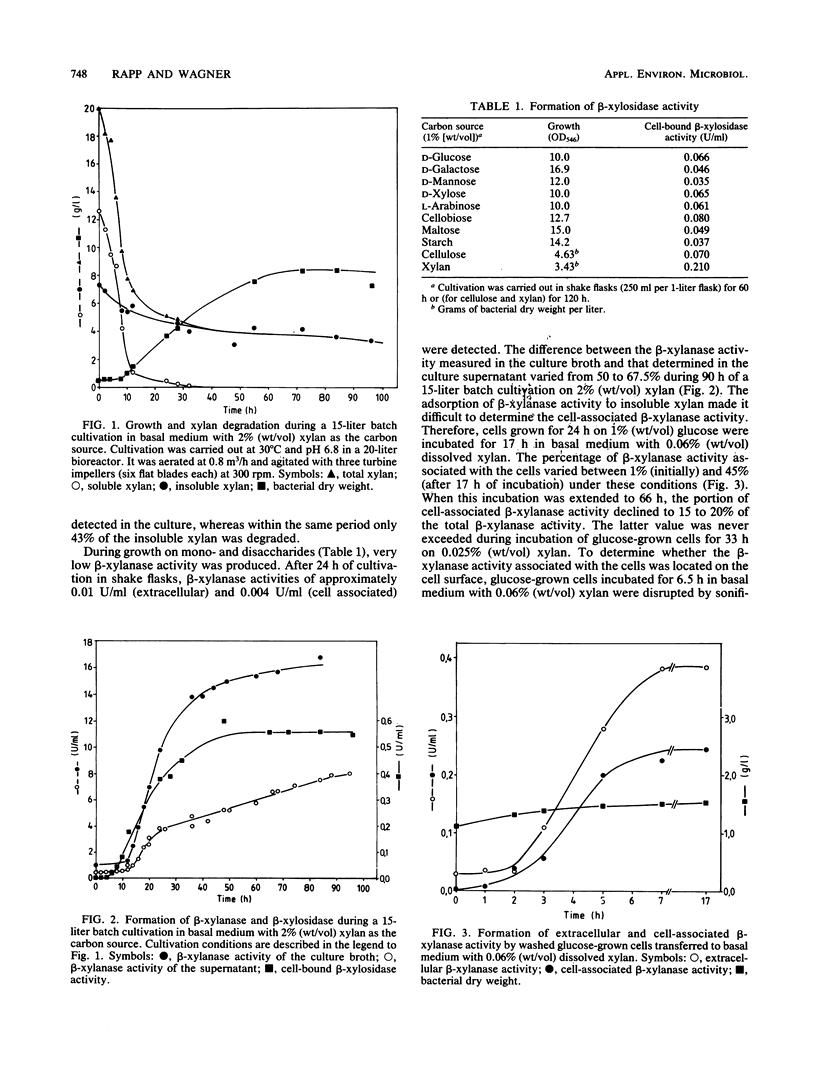

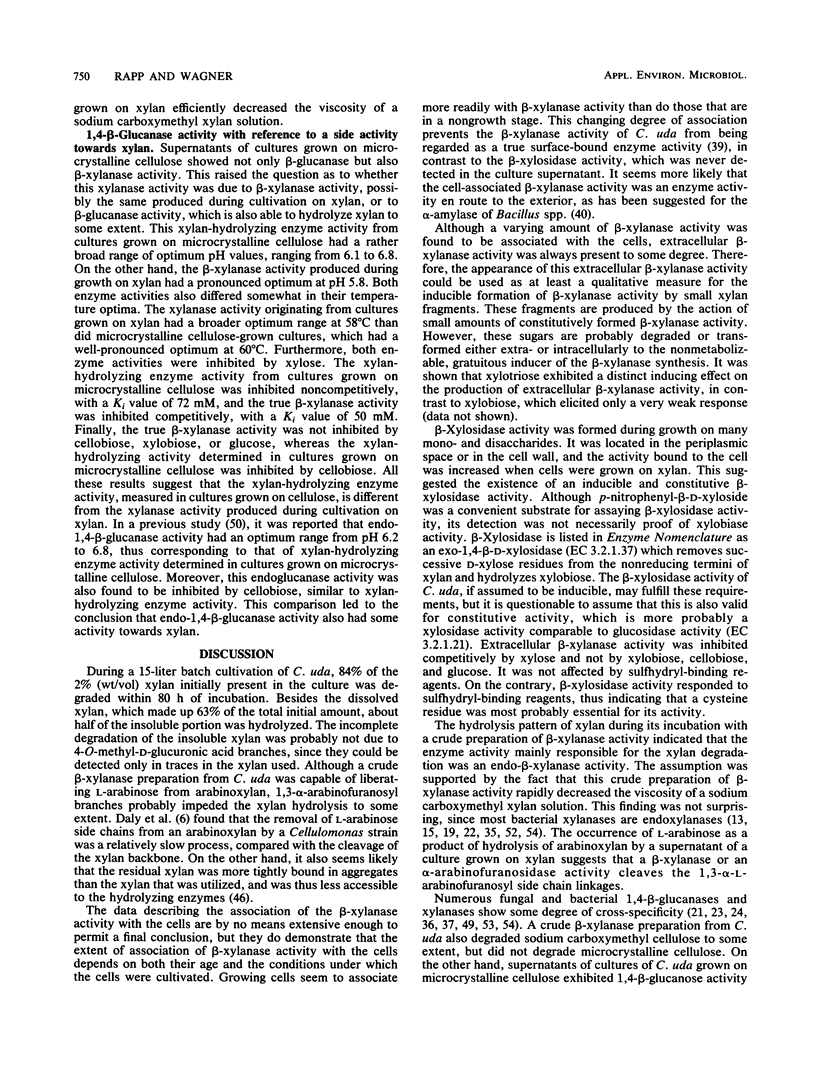
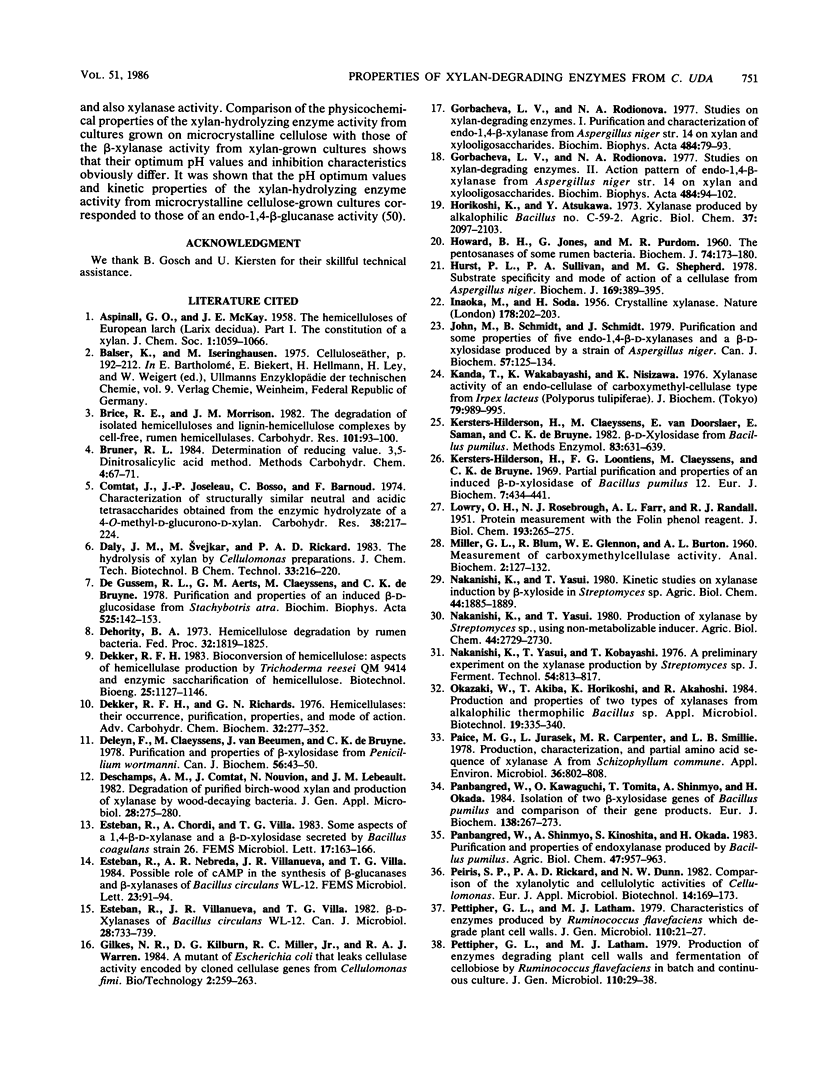
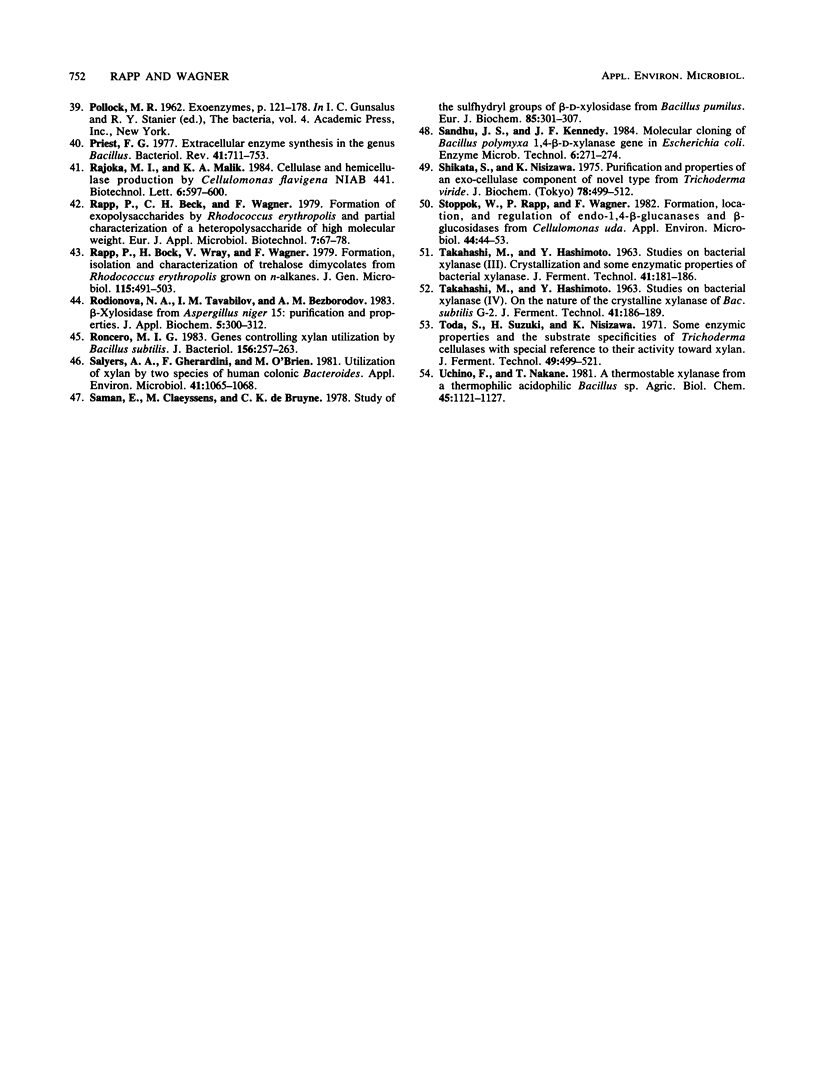
Selected References
These references are in PubMed. This may not be the complete list of references from this article.
- Comtat J., Joseleau J. P., Bosso C., Barnoud F. Characterization of structurally similar neutral and acidic tetrasaccharides obtained from the enzymic hydrolyzate of a 4-O-methyl-D-glucurono-D-xylan. Carbohydr Res. 1974 Dec;38:217–224. doi: 10.1016/s0008-6215(00)82352-6. [DOI] [PubMed] [Google Scholar]
- Dehority B. A. Hemicellulose degradation by rumen bacteria. Fed Proc. 1973 Jul;32(7):1819–1825. [PubMed] [Google Scholar]
- Dekker R. F., Richards G. N. Hemicellulases: their occurrence, purification, properties, and mode of action. Adv Carbohydr Chem Biochem. 1976;32:277–352. doi: 10.1016/s0065-2318(08)60339-x. [DOI] [PubMed] [Google Scholar]
- Deleyn F., Claeyssens M., Van Beeumen J., De Bruyne C. K. Purification and properties of beta-xylosidase from Penicillium wortmanni. Can J Biochem. 1978 Jan;56(1):43–50. doi: 10.1139/o78-007. [DOI] [PubMed] [Google Scholar]
- Gorbacheva I. V., Rodionova N. A. Studies on xylan degrading enzymes. I. Purification and characterization of endo-1,4-beta-xylanase from Aspergillus niger str. 14. Biochim Biophys Acta. 1977 Sep 15;484(1):79–93. doi: 10.1016/0005-2744(77)90114-0. [DOI] [PubMed] [Google Scholar]
- Gorbacheva I. V., Rodionova N. A. Studies on xylan-degrading enzymes. II. Action pattern of endo-1,4-beta-xylanase from Aspergillus niger str. 14 on xylan and xylooligosaccharides. Biochim Biophys Acta. 1977 Sep 15;484(1):94–102. doi: 10.1016/0005-2744(77)90115-2. [DOI] [PubMed] [Google Scholar]
- HOWARD B. H., JONES G., PURDOM M. R. The pentosanases of some rumen bacteria. Biochem J. 1960 Jan;74:173–180. doi: 10.1042/bj0740173. [DOI] [PMC free article] [PubMed] [Google Scholar]
- Hurst P. L., Sullivan P. A., Shepherd M. G. Substrate specificity and mode of action of a cellulase from Aspergillus niger. Biochem J. 1978 Feb 1;169(2):389–395. doi: 10.1042/bj1690389. [DOI] [PMC free article] [PubMed] [Google Scholar]
- John M., Schmidt B., Schmidt J. Purification and some properties of five endo-1,4-beta-D-xylanases and a beta-D-xylosidase produced by a strain of Aspergillus niger. Can J Biochem. 1979 Feb;57(2):125–134. doi: 10.1139/o79-016. [DOI] [PubMed] [Google Scholar]
- Kanda T., Wakabayashi K., Nisizawa K. Xylanase activity of an endo-cellulase of carboxymethyl-cellulase type from Irpex lacteus (Polyporus tulipiferae). J Biochem. 1976 May;79(5):989–995. doi: 10.1093/oxfordjournals.jbchem.a131166. [DOI] [PubMed] [Google Scholar]
- Kersters-Hilderson H., Claeyssens M., Van Doorslaer E., Saman E., De Bruyne C. K. beta-D-xylosidase from Bacillus pumilus. Methods Enzymol. 1982;83:631–639. doi: 10.1016/0076-6879(82)83062-0. [DOI] [PubMed] [Google Scholar]
- Kersters-Hilderson H., Loontiens F. G., Claeyssens M., De Bruyne C. K. Partial purification and properties of an induced beta-D-xylosidase of Bacillus pumilus 12. Eur J Biochem. 1969 Jan;7(3):434–441. doi: 10.1111/j.1432-1033.1969.tb19628.x. [DOI] [PubMed] [Google Scholar]
- LOWRY O. H., ROSEBROUGH N. J., FARR A. L., RANDALL R. J. Protein measurement with the Folin phenol reagent. J Biol Chem. 1951 Nov;193(1):265–275. [PubMed] [Google Scholar]
- Paice M. G., Jurasek L., Carpenter M. R., Smillie L. B. Production, characterization, and partial amino acid sequence of xylanase A from Schizophyllum commune. Appl Environ Microbiol. 1978 Dec;36(6):802–808. doi: 10.1128/aem.36.6.802-808.1978. [DOI] [PMC free article] [PubMed] [Google Scholar]
- Panbangred W., Kawaguchi O., Tomita T., Shinmyo A., Okada H. Isolation of two beta-xylosidase genes of Bacillus pumilus and comparison of their gene products. Eur J Biochem. 1984 Jan 16;138(2):267–273. doi: 10.1111/j.1432-1033.1984.tb07911.x. [DOI] [PubMed] [Google Scholar]
- Priest F. G. Extracellular enzyme synthesis in the genus Bacillus. Bacteriol Rev. 1977 Sep;41(3):711–753. doi: 10.1128/br.41.3.711-753.1977. [DOI] [PMC free article] [PubMed] [Google Scholar]
- Rodionova N. A., Tavobilov I. M., Bezborodov A. M. beta-Xylosidase from Aspergillus niger 15: purification and properties. J Appl Biochem. 1983 Aug-Oct;5(4-5):300–312. [PubMed] [Google Scholar]
- Roncero M. I. Genes controlling xylan utilization by Bacillus subtilis. J Bacteriol. 1983 Oct;156(1):257–263. doi: 10.1128/jb.156.1.257-263.1983. [DOI] [PMC free article] [PubMed] [Google Scholar]
- Salyers A. A., Gherardini F., O'Brien M. Utilization of xylan by two species of human colonic Bacteroides. Appl Environ Microbiol. 1981 Apr;41(4):1065–1068. doi: 10.1128/aem.41.4.1065-1068.1981. [DOI] [PMC free article] [PubMed] [Google Scholar]
- Saman E., Claeyssens M., de Bruyne C. K. Study of the sulfhydryl groups of beta-D-xylosidase from Bacillus pumilus. Eur J Biochem. 1978 Apr;85(1):301–307. doi: 10.1111/j.1432-1033.1978.tb12239.x. [DOI] [PubMed] [Google Scholar]
- Shikata S., Nsizawa K. Purification and properties of an exo-cellulase component of novel type from Trichoderma miride. J Biochem. 1975 Sep;78(3):499–512. doi: 10.1093/oxfordjournals.jbchem.a130934. [DOI] [PubMed] [Google Scholar]
- Stoppok W., Rapp P., Wagner F. Formation, Location, and Regulation of Endo-1,4-beta-Glucanases and beta-Glucosidases from Cellulomonas uda. Appl Environ Microbiol. 1982 Jul;44(1):44–53. doi: 10.1128/aem.44.1.44-53.1982. [DOI] [PMC free article] [PubMed] [Google Scholar]
- de Gussem R. L., Aerts G. M., Claeyssens M., de Bruyne C. K. Purification and properties of an induced beta-D-glucosidase from stachybotrys atra. Biochim Biophys Acta. 1978 Jul 7;525(1):142–153. doi: 10.1016/0005-2744(78)90208-5. [DOI] [PubMed] [Google Scholar]


